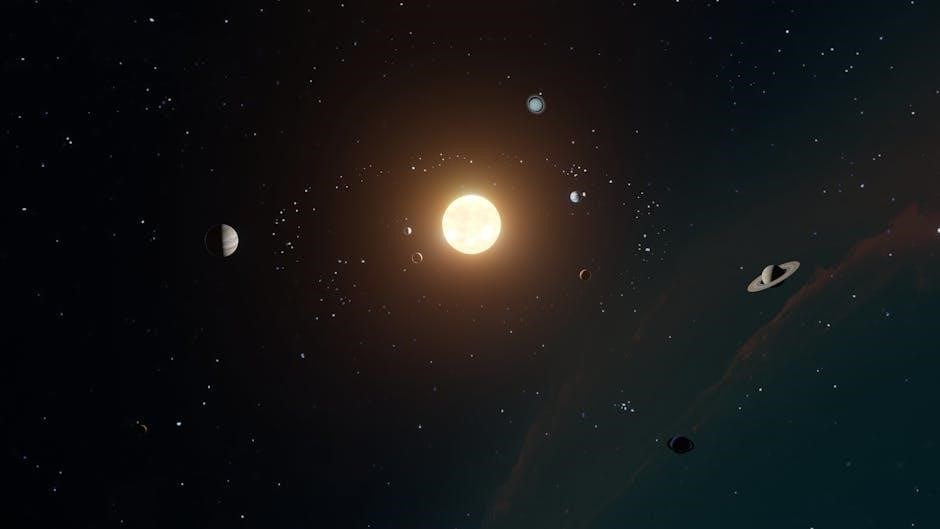Explore the Solar System through engaging reading passages and activities. This PDF enhances learning by focusing on comprehension skills, vocabulary, and critical thinking about planets, stars, and space.
What is the Solar System?
The Solar System consists of the Sun and all objects that orbit around it, including planets, moons, asteroids, comets, and other celestial bodies. At its center is the Sun, a massive ball of hot gas that provides light and heat, essential for life on Earth.
There are eight planets in the Solar System, each unique in size, composition, and characteristics. Terrestrial planets like Mercury, Venus, Earth, and Mars are rocky, while gas giants like Jupiter and Saturn are primarily composed of gases. Beyond them are Uranus and Neptune, the ice giants. Dwarf planets, such as Pluto, and smaller bodies like asteroids and comets also orbit the Sun, contributing to the Solar System’s diversity and complexity.
Understanding the Solar System helps us explore the universe’s structure and our place within it, fostering curiosity and learning about space and astronomy.
Why Reading Comprehension is Important for Understanding the Solar System
Reading comprehension is a vital skill for understanding the Solar System, as it enables students to interpret complex scientific texts and grasp key concepts. By engaging with passages about planets, stars, and celestial phenomena, learners develop critical thinking and analytical abilities. This skill is essential for processing information about the Solar System’s structure, the roles of the Sun and planets, and the relationships between different celestial bodies. Strong comprehension fosters a deeper appreciation of astronomy and prepares students for advanced scientific studies. Moreover, it enhances vocabulary and communication skills, which are crucial for discussing and sharing knowledge about space. Effective reading comprehension activities ensure a solid foundation for exploring the wonders of the Solar System.

The Planets in the Solar System
The Solar System includes eight planets, each unique in composition and orbit. They are divided into terrestrial and gas giants, offering insights into celestial diversity and formation.
Terrestrial Planets: Mercury, Venus, Earth, and Mars
The terrestrial planets—Mercury, Venus, Earth, and Mars—are rocky worlds with iron cores. Mercury, the smallest and closest to the Sun, has a heavily cratered surface. Venus, often called Earth’s twin due to their similar size, is shrouded in thick clouds of sulfuric acid and carbon dioxide, making it the hottest planet. Earth, our home, is the only known planet with life, supported by its perfect distance from the Sun and abundant water. Mars, with its reddish hue, is a potential candidate for future human exploration, featuring valleys, craters, and polar ice caps. These planets offer insights into the formation and diversity of rocky worlds in the Solar System.
Gas and Ice Giants: Jupiter, Saturn, Uranus, and Neptune
The gas and ice giants—Jupiter, Saturn, Uranus, and Neptune—are the largest planets, primarily composed of hydrogen and helium. Jupiter, the biggest planet, boasts a massive storm known as the Great Red Spot. Saturn is famous for its stunning rings made of ice and rock. Uranus and Neptune, the ice giants, have icy blue atmospheres and are the farthest from the Sun. These planets play a crucial role in the Solar System’s structure, influencing smaller celestial bodies and maintaining orbital balance. Their unique features and compositions provide valuable insights into the Solar System’s formation and evolution.
Dwarf Planets and Other Celestial Bodies
Dwarf planets, like Pluto, Eris, and Ceres, are smaller celestial bodies that orbit the Sun but do not meet the criteria to be classified as full planets. Pluto, once considered the ninth planet, is now categorized as a dwarf planet due to its smaller size and unique orbital pattern. Other dwarf planets exist in the Kuiper Belt and asteroid belt, offering insights into the Solar System’s formation. Additionally, the Solar System includes asteroids, comets, and meteoroids, which are remnants from its creation. These smaller bodies provide valuable information about the Solar System’s history and composition, making them fascinating subjects for study and exploration.

The Sun and Its Role in the Solar System
The Sun is the Solar System’s central star, providing light, heat, and energy essential for life. Its gravity holds planets in orbit, sustaining cosmic balance and enabling life on Earth.
Structure of the Sun
The Sun is a massive ball of hot, glowing gas, primarily hydrogen and helium. Its structure includes the core, where nuclear fusion occurs, producing vast energy. Surrounding the core are the radiative and convective zones, which transfer energy outward. The photosphere is the visible surface, emitting light and heat. Above it lies the chromosphere and corona, visible during solar eclipses. The Sun’s layered structure enables it to generate and distribute energy, sustaining the Solar System. This composition and function are vital for understanding its role in our cosmic environment.
The Sun’s Importance to Life on Earth
The Sun is central to life on Earth, providing essential light, heat, and energy. Its rays drive photosynthesis, enabling plants to produce oxygen and food, forming the base of the food chain. Without the Sun, Earth would be a cold, lifeless planet. The Sun’s energy powers weather patterns, ocean currents, and the water cycle, regulating Earth’s climate. It supports biodiversity and agriculture, ensuring the survival of ecosystems. The Sun’s importance extends to human health, influencing vitamin D production and mental well-being. In summary, the Sun is vital for sustaining life and maintaining the balance of Earth’s natural systems.

Astronomical Features of the Solar System
Astronomical features of the Solar System include asteroids, comets, meteoroids, the Kuiper Belt, and the Oort Cloud. These elements, along with moons and planetary rings, shape our cosmic environment.
Asteroids, Comets, and Meteoroids
Asteroids, comets, and meteoroids are small celestial bodies that orbit the Sun. Asteroids are rocky objects primarily found in the asteroid belt between Mars and Jupiter. Comets are icy bodies that release gas and dust as they approach the Sun, creating bright tails. Meteoroids are small debris that burn up in Earth’s atmosphere, producing meteors or “shooting stars.” These objects provide insights into the Solar System’s formation and evolution. Educational resources, such as reading comprehension PDFs, often include passages and activities about these astronomical features, helping students understand their roles in the Solar System’s structure and history. These materials engage learners with interactive exercises and quizzes to enhance their knowledge and critical thinking skills.
The Kuiper Belt and Oort Cloud
The Kuiper Belt and Oort Cloud are distant regions in the Solar System. The Kuiper Belt, located beyond Neptune, contains icy bodies, including dwarf planets like Pluto. The Oort Cloud, a spherical shell around the Solar System, holds comets that may take thousands of years to orbit the Sun. These regions are remnants from the Solar System’s formation, offering clues about its history. Reading comprehension PDFs often feature passages on these areas, helping students grasp their significance. Activities include matching games, fill-in sentences, and discussions, fostering deeper understanding of these mysterious regions and their role in the Solar System’s structure. These resources make learning about the Kuiper Belt and Oort Cloud engaging and interactive.

Educational Resources for Solar System Reading Comprehension
Premium Solar System Reading Comprehension PDFs include engaging worksheets, activities, and passages. These resources enhance learning for students of all levels, fostering understanding and curiosity about space.
PDF Worksheets and Activities for Students
Engage students with comprehensive Solar System Reading Comprehension PDFs. These resources include reading passages, vocabulary exercises, and interactive activities like matching games and fill-in-the-blank exercises. Designed for various skill levels, they cater to different learning needs, fostering both reading proficiency and scientific knowledge. Activities such as drawing planets, labeling diagrams, and answering discussion questions encourage hands-on learning. Many worksheets also incorporate cross-curricular elements, connecting science with language arts. Teachers can use these tools to assess understanding and promote critical thinking. With a focus on fun and education, these PDFs make learning about the Solar System an enjoyable and enriching experience for students of all ages.
How to Use Reading Comprehension Exercises Effectively
To maximize the benefits of Solar System Reading Comprehension PDFs, start with guided reading sessions to introduce key concepts. Encourage students to read passages aloud or independently, depending on their skill level. After reading, lead class discussions to clarify misunderstandings and emphasize critical details. Use the provided comprehension questions to assess understanding, ensuring students can identify main ideas and supporting details. Incorporate activities like vocabulary matching and sentence completion to reinforce learning. For advanced students, assign open-ended questions to foster deeper thinking. Teachers should provide feedback and encourage students to revisit challenging sections. Regular practice with these exercises helps build confidence and improves reading and science skills simultaneously, making learning engaging and effective.
Mastering the Solar System through reading comprehension PDFs enhances learning and exploration. These resources provide engaging passages, vocabulary, and questions, fostering a deeper understanding of space and its wonders.
Key Takeaways from the Solar System Reading Comprehension PDF
Learning about the Solar System through reading comprehension PDFs offers a comprehensive understanding of planets, celestial bodies, and their roles. These resources provide engaging passages, vocabulary exercises, and critical thinking questions to enhance knowledge retention. Students discover how planets differ, the importance of the Sun, and fascinating facts about asteroids, comets, and the Kuiper Belt. Interactive activities like matching words and filling in sentences make learning fun and effective. The PDFs are designed for various skill levels, ensuring accessibility for all learners. By completing these exercises, students gain a deeper appreciation for space and its mysteries, fostering curiosity and a love for science.
Encouraging Further Learning and Exploration
The Solar System Reading Comprehension PDF is designed to spark curiosity and inspire further exploration of space. By engaging with the text, students develop a strong foundation in astronomy and critical thinking. Interactive activities, such as matching games, fill-in sentences, and drawing tasks, make learning fun and immersive. The inclusion of discussion questions and cross-curricular projects encourages collaboration and deeper understanding. These resources cater to diverse learning styles, ensuring every student can participate and grow. Whether through lapbook projects or advanced reading passages, the PDF motivates learners to delve deeper into the wonders of the Solar System. It fosters a love for science and prepares students for more complex topics in the future.
